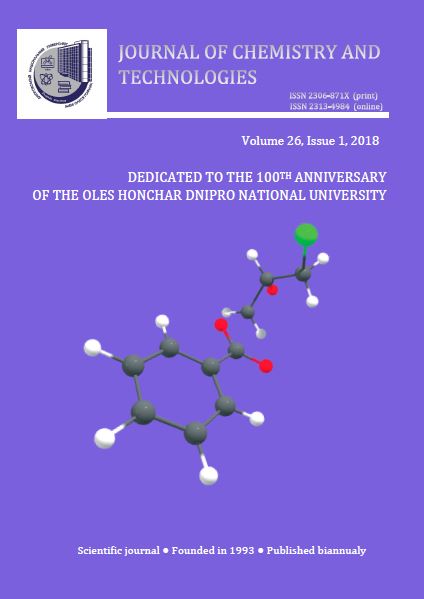STUDY OF THE INTERACTIONOF Hg (II) WITH POTASSIUM TRIIODIDE UNDER THE CONDITIONS OF ELEKTROTITRIMETRY
DOI:
https://doi.org/10.15421/081805Keywords:
multiligand complexes, potassium triiodide, electrochemical methodsAbstract
The processes of interaction of mercury(II) with potassium triiodide have been studied in various media by potentiometric and biamperometric methods. It was concluded that acetate buffer solutions with pH 4–6 are the optimal background electrolyte. It has been established that the formation of the final products i.e. HgI2 and Hg(IO3)2 proceeds with the formation of intermediate mixed complexes with acetate ions. It was shown that the platinum electrode is amalgamated as a result of continuous work with solutions of mercury. In connection with this, the anomalous curves of biamperometric titration of mercury (II) with KI3 solution were obtained. In potentiometric titration, a decisive contribution to the magnitude of the potential is made by mixed oxidation-reduction potentials. The obtained results were used for the development of the procedure for the determination of mercury (II) by potassium triiodide with fixation of the equivalence point by electrochemical methods.
References
Koltgof, I. M., Belcher, G., Stenger, V. A., Matsuyami, Dzh. (1961). [Ob'emnyiy analiz. V. 3]. USSR, Moscow: Goskhimizdat (in Russian).
Novokhatko, O. V., Avdienko, T. N., Suprunovich, V. I. (2003). Ispolzovanie rastvorov triyodida kaliya dlya ekspressnogo opredeleniya serebra(I) s vizualnoy fiksatsiey tochki ekvivalentnosti. Zavodskaya laboratoriya. Diagnostika materialov – Industrial laboratory. Diagnostics of materials. 69(1), 16-18 (in Russian).
Yaroshenko, M. V., Novokhatko, O. V., Suprunovich, V. I. (2006). Ispolzovanie elektrotitrimetrii dlya opredeleniya kachestva komponentov okruzhayushchey sredy. Vіsn. Kremench. Derzh. Polіtekh. Unіv. 2, 124-125 (in Russian).
Suprunovich, V. I., Yaroshenko, M. V. (2006). O vzaimodejstvii odnovalentnoj rtuti so smes’ju joda I jodistogo kalija. Voprosy Khimii i Khimicheskoi Tekhnologii – Issues of Chemistry and Chemical Technology. 5, 20-23 (in Russian).
Suprunovich, V. I., Yaroshenko, M. V. (2008). Jekspressnoe opredelenie zolota(III) v platinosoderzhashhih rastvorah s vizualnoj fiksaciej konechnoj tochki titrovanija. Voprosy Khimii i Khimicheskoi Tekhnologii – Issues of Chemistry and Chemical Technology. 1, 24-26 (in Russian).
Manzyuk, M. V., Suprunovich, V. I., Avdienko, T. N., Zimina, S. V., Trachevskiy, V. V. (2016). The Outer-Sphere Formation of Complexes in the System of H2PtCl6–Ce(SO4)2–H2SO4–KI in Conditions of Electrochemical Determination of Platinum(IV). Res. J. Pharm., Biol. Chem. Sci. 7(1), 1638-1644.
Manzyuk, M. V., Avdienko, T. N., Suprunovich, V. I. (2016). Opredelenie platiny jodidom kilija elektrochimicheskimi metodami. Privolzhsk. Nauch.Vestn. (1), 28-31 (in Russian).
Korostelev, P.P. (1962). [Prigotovlenie rastvorov dlya khimiko-analiticheskikh rabot]. USSR, Moscow: Izd-vo Akademii nauk SSSR (in Russian).
Usatenko, Yu. I., Suprunovich, V. I., Kulikovskaya, Zh. B. (1971). Sintez i issledovanie smeshannykh kompleksnykh soedineniy dvukhvalentnoy rtuti s tiooksinom i galogenami. J. Inorg. Chem., 16 (12), 3200-3205 (in Russian).
Hernandez, G., Bernes, S., Portillo, O., Ruiz, A., Moreno, GR (2015). Crystal structures of three mercury(II) complexes [HgCl2L] where L is a bidentate chiral imine ligand. Acta Crystallogr E Crystallogr Commun. 71(12), 1462-1466. https://doi.org/10.1107/S2056989015020368
Kornev, V. I., Kardapol’tsev, A. A. (2008) Heteroligand mercury(II) complexes with aspartic, tartaric, and citric. Russ. J. Coord. Chem. 34, (12), 896–900.
Tulenbaeva, M. A. (2016) Raznoligandnye kompleksy zinka, rtuti s geksametilentetraminom I dimetilsul’foksidom. Nauka, technika I obrazovanie (10), 23-25 (in Russian).
Kornev, V. I., Kardapol’cev, A. A., Kropacheva, T. N., Batueva, E. V. (2012). Geteroligandnye kompleksy rtuti(II) s monoaminnymi karboksimetil’nymi kompleksonami I jablochnoi kislotoj v vodnom rastvore. Vestn. Udmurt. Univ. (2), 55-60 (in Russian).
Kuliev, K. A., Mamedova, R. A. (2016) Jekstrakcija rtuti(II) iz ditiolfenoljatnyh rastvorov v hloroform v prisutstvii gidrofobnyh aminov. Izv.vuzov. Prikl.khimija I biotehn. 6(4), 34-45. (in Russian). https://doi.org/10.21285/2227-2925-2016-6-4-34-45
Lukachina, V. V. (1988). [Ligand-ligandnoe vzaimodeystvie i ustoychivost raznoligandnykh kompleksov]. Kiev: Naukova dumka (in Russian).
Suprunovich, V. I., Usatenko, Yu. I, Kulikovskaya, Zh. B. (1972). Izuchenie vzaimodeystviya atsetatnykh kompleksov rtuti i medi s 8-merkaptokhinolinom.
J. Anal. Chem., 27 (8), 1492-1497 (in Russian).
Grigorev, A. I. (1963). Infrakrasnye spektry pogloshcheniya atsetatov elementov 1 i 2 grupp periodicheskoy sistemy. J. Inorg. Chem., 8(8), 802-809 (in Russian).
Zakharov, V. A. Songina, O. A., Perzeman, L. N. (1960). Amperometricheskiy metod opredeleniya rtuti na vrashchayushchemsya platinovom. Ind. Lab. (Diagn. Mater.), 26(7), 787-792 (in Russian).
Songina, O. A., Zakharov, V. A. (1962). O zavisimosti khoda krivykh amperometricheskogo titrovaniya rtuti yodida kaliya ot potentsiala indikatornogo elektroda Ind. Lab. (Diagn. Mater.), 28(8), 908-910 (in Russian).
Songina, O. A., Dausheva, M. R. (1965). Elektrokhimicheskoe vosstanovlenie trudnorastvorimykh soedineniy rtuti. Electrochemistry. 5(12), 1464-1468 (in Russian).
Suprunovich, V. I. (1985). Raznoligandnye i raznometallnye koordinatsionnye soedineniya S- i N-soderzhashchikh organicheskikh reagentov dlya selektivnogo i kompleksnogo analiza materialov: Avtoref. dis.…d.kh.n. – Dnepropetrovsk (in Russian).
Agasyan, P. K., Nikolaeva, Ye. R. (1986). [Osnovy elektrokhimicheskikh metodov analiza (potentsiometricheskiy metod)]. USSR, Moscow: Izd-vo MGU(in Russian).
Downloads
Published
Issue
Section
License
Copyright (c) 2018 Oles Honchar Dnipro National University

This work is licensed under a Creative Commons Attribution 4.0 International License.
- Authors reserve the right of attribution for the submitted manuscript, while transferring to the Journal the right to publish the article under the Creative Commons Attribution License. This license allows free distribution of the published work under the condition of proper attribution of the original authors and the initial publication source (i.e. the Journal)
- Authors have the right to enter into separate agreements for additional non-exclusive distribution of the work in the form it was published in the Journal (such as publishing the article on the institutional website or as a part of a monograph), provided the original publication in this Journal is properly referenced
- The Journal allows and encourages online publication of the manuscripts (such as on personal web pages), even when such a manuscript is still under editorial consideration, since it allows for a productive scientific discussion and better citation dynamics (see The Effect of Open Access).


